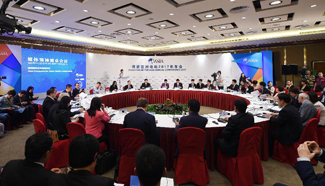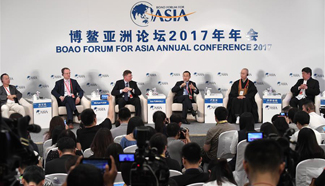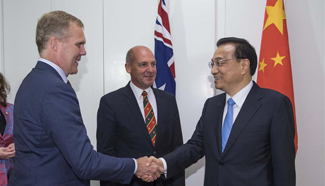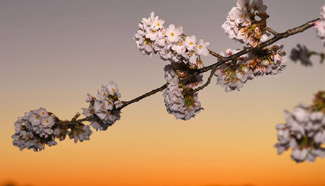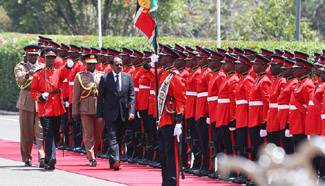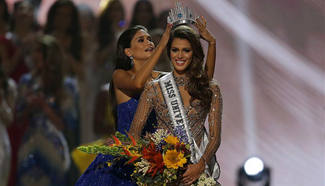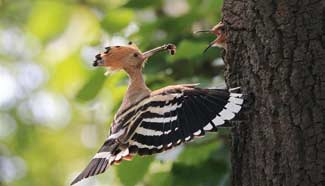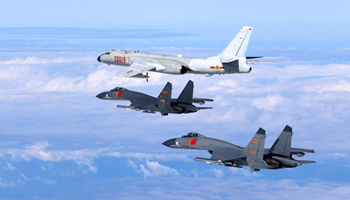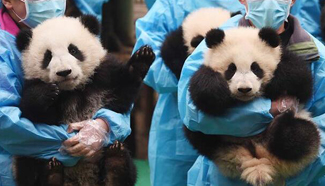by Xinhua Writer Xu Haijing
CANBERRA, March 24 (Xinhua) -- When Bernard Wright retired from his position of clerk, the most senior official in the House of Representatives, four years ago, he began to run a family farm 140 km north of Canberra.
For the first time in four years, he was able to invest in a new yard and shed for the farm thanks to the increased revenue brought by the free trade agreement Australia has signed with China.
In his farm of 810 hectares, Wright keeps 2,200 sheep for wool. Of the 10,000 to 12,000 kg of wool produced every year, 75 percent will go to China. For the 200 beef cattle at the farm, he got a better price as a result of the China-Australia Free Trade Agreement (ChAFTA), signed by the two countries in June 2015.
Ratified by the legislative bodies of the two countries, ChAFTA went into effect on Dec. 20, 2015, immediately bringing down tariffs for Australian beef, wine, fruits and other products to enable them easier access to the Chinese market.
Wright told Xinhua that ChAFTA eliminated the quota for Australian wool to be exported to China. The volume of wool production in his farm in 2016 increased more than 50 percent compared to that of a year ago.
Before ChAFTA, China already provided virtually duty-free access for wool, under a large World Trade Organization (WTO) tariff rate quota of 287,000 tons. Under ChAFTA, in addition to the existing WTO quota, Australia received an exclusive duty-free Country Specific Quota of 30,000 tons of clean wool from Jan. 1, 2016.
This volume will grow by 5 percent each year to 44,324 tons of clean wool by 2024, all at duty-free rates. This is the best outcome China has provided in any of its FTAs to date.
Wright has used the increased revenue from more wool and beef sales to build the new yard and shed, and provide better veterinary treatment for the cattle. With new machinery and more fertilizer, he is optimistic he will have an even better year ahead.
His son harbors the ambition to begin planting grape vines on the farm, aiming to export wine in a few years to the Chinese market.
The wine industry is another of ChAFTA's success stories.
Before ChAFTA, China was Australia's second-largest export market for wine, worth 415 million Australian dollars (about 320 million U.S. dollars) in 2015 to 2016. Australian wine was subject to a 14-percent tariff before it hit Chinese shelves.
Now just a year later, with the tariff reduced to 5.6 percent, China has already become Australia's largest export market for wine, with the export industry now worth almost 375 million U.S. dollars annually. ChAFTA also gives Australian wine makers a significant edge in the competition against fellow wine exporters from the Old World.
Tony Battaglene from the Winemakers' Federation said as the tariff rate continues to decrease before hitting zero by 2019, Australian winemakers and exporters can get a real leg up on the competition.
"We've got around 24 percent, 25 percent of their (Chinese) market ahead of France. We're now beating the Old World at their game so that's a really good outcome for us," Battaglene said in an Australian Broadcasting Corporation (ABC) interview.
There are many similar success stories.
In a statement on March 17, Australian Prime Minister Malcolm Turnbull said: "China is our largest trading partner, with two-way trade of 150 billion AU dollars (about 116 billion U.S. dollars) in 2016."
ChAFTA "has greatly strengthened trade and investment between our two countries, driving growth and job creation. We continue to see record bilateral investment, education exchanges and a booming tourism sector with close to 2 million journeys between our two countries in 2016," said Turnbull.
While the previous model of China-Australia economic cooperation can be called a mining boom, now it is more appropriate to speak of a free trade boom.
New opportunities have been created in the fields of agriculture, services, innovation and investment, among others. As both countries are in the midst of an economic transition, ChAFTA opens new windows of opportunity for both China and Australia.





